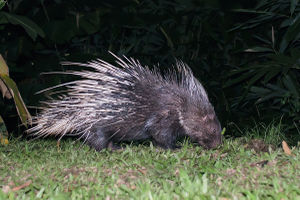Essay: Porcupine Classification
According to evolutionists, porcupines evolved twice convergently. They claim the quills are the result are the result of " convergent evolution". This essay will explore a different possibility, namely that Old World and New World porcupines are members of the same Baramin and that the evolutionist taxonomic system is deeply errant.
Justifying the "lumping" of Old World and New World porcupines into a single baramin
Old World (Hystricid) and New World (Erethizontid) porcupines are remarkably similar. Both have long quills, a tubby body shape and cavimorph dentition. In addition, both have comparatively thick tails, which they can swing at enemies to belabor them with quills. [1][2]
In fact, the only significant difference I can find between the two groups is that Hystricids have no spines on the front third to half of their bodies. Therefore, I consider them similar enough to be grouped into a single baramin. Additionally, this fits common sense. Why would God make one kind of porcupine for the Old World and one for the New? That is too complicated and generally unnecessary.
Hypothesizing on traits of the original members of the porcupine baramin
Porcupines have strong tails they can use to shake quills at enemies. [3] Some New World Porcupines (those of the genus Coendou) have long prehensile tails. [4] This poses an interesting problem. According to evolutionists, the tail evolved through Natural selection. However, this poses a few problems considering known science, most especially the lack of documented evolution of new information. [5] I propose that the prehensile tails of the Coendou New World Porcupines are in fact a textbook example of De-evolution and loss of information. For example, the part of their tail these porcupines grip with is spineless, which means that it must have lost the information to grow spines on that part of its tail. Not only that, but the long, comparatively nonspiny tail is far less useful to shake at predators than a normal porcupine one.
References
- ↑ http://www.sheppardsoftware.com/content/animals/animals/mammals/porcupine.htm
- ↑ http://www.catskillmountaineer.com/animals-porcupine.html
- ↑ https://answersingenesis.org/kids/mammals/porcupine/
- ↑ https://www.uwsp.edu/biology/VertebrateCollection/Pages/Vertebrates/Mammals%20of%20Paraguay/Coendou%20prehensilis/Coendou%20prehensilis.aspx
- ↑ https://creation.com/meta-information


